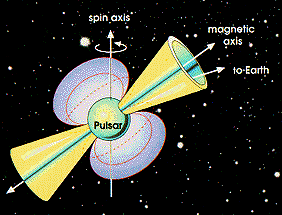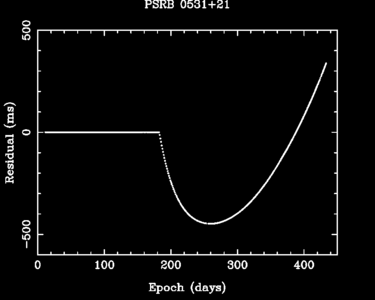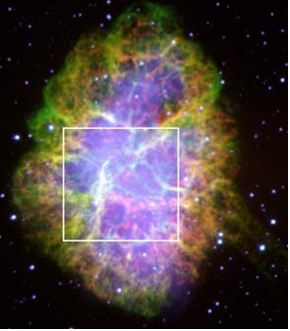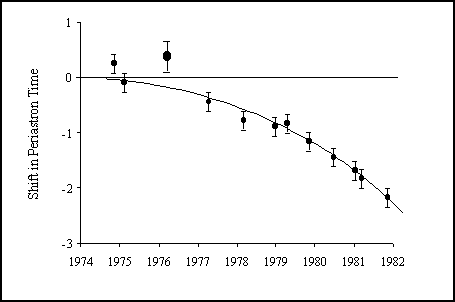Pulsars
- Introduction
- Discovery
- How pulsars work
- Period of a pulsar
- Notable examples
- Other attributes
- Sources
Introduction
A pulsar is a rotating neutron star that emits radiation at a regular frequency.
Discovery
Pulsars were discovered by Jocelyn Hewish and Anthony Bell, who observed pulses of radio waves. They initially dubbed them LGMs (for “Little Green Men”), as they thought aliens could be sending these waves. They received the Nobel Prize in Physics for this discovery.
How pulsars work
Pulsars are thought to be rotating neutron stars. They can be described by the “lighthouse model” – radiation is emitted from the poles, which “sweeps” through space as the pulsar rotates. This mechanism was first proposed by Thomas Gold.


Period of a pulsar
The period of a pulsar is the time between pulses it emits. Periods are typically a few seconds long and are very regular. However, periods usually get longer over long periods of time, as the pulsar loses energy and begins to slow down.

Glitches
Sometimes pulsars suddenly speed up in glitches, drastically changing their periods. They are thought to be caused by starquakes. Starquakes occur in neutron stars when their crust suddenly shifts, like an earthquake on Earth.

In a starquake, the neutron star shrinks to become more spherical. This decreases the moment of inertia, thus increasing angular momentum by conservation of energy. The pulsar speeds up and its period decreases.

Millisecond pulsars
Pulsars are divided into two types: millisecond and ordinary. A millisecond pulsar has a period of only a few milliseconds. Millisecond pulsars are found in the bottom left of the P-Pdot diagram; they have a small period that varies only very slightly.
Millisecond pulsars are thought to be formed when an old, slow pulsar starts accreting matter from another star that is orbiting with it in a binary system. As matter is transferred to it, the pulsar increases its angular momentum and speeds up, becoming a millisecond pulsar or a recycled pulsar.
Notable examples
Crab pulsar

The Crab Nebula contains a pulsar in its center.
Hulse–Taylor binary pulsar
The Hulse–Taylor binary pulsar (PSR 1913+16) was the first binary pulsar to be observed. According to general relativity, its period should slowly decrease, as it loses energy and moves closer together and faster.
Measurements have confirmed that it has a slow decrease in its period. This decrease provided evidence for the existence of gravitational waves, thus confirming a key part of the theory of general relativity.

Gravitational waves
Gravitational waves are radiation caused by massive objects that move around in spacetime. They are predicted by the theory of general relativity. As stars in a binary system emit gravitational waves, they lose energy, so they move closer together and faster, causing the period to decrease.
Gravitational waves have not been directly observed yet. LIGO (Laser Interferometer Gravitational-Wave Observatory) is an ongoing experiment that aims to detect gravitational waves.
PSR B1257+12
Aleksander Wolszczan and Dale Frail discovered the first known exoplanets around here. They did this by examining the anomalies in the planet’s period, as it is a millisecond pulsar.
Other attributes
Characteristic age
The characteristic age of a pulsar is defined as:

is period, is the period derivative (rate at which period is slowing). is the braking index, which represents the energy loss of the magnet. It can be approximated as 3 for a rotating dipolar magnet in a perfect vacuum.
This formula is used to estimate the age of pulsars.
P-Pdot diagram
 A P-Pdot diagram is used to show the lifecycle of pulsars. Pulsars are born in the upper left (small periods that slow down fast), and older pulsars are found around the middle.
A P-Pdot diagram is used to show the lifecycle of pulsars. Pulsars are born in the upper left (small periods that slow down fast), and older pulsars are found around the middle.
Pulsar dispersion
 Pulses at higher frequencies reach Earth before pulses of lower frequencies. This is because pulses of lower frequencies interacti more with free electrons in the interstellar medium, while higher-frequency photons are less effected. So, de-dispersion is needed to correct for this effect, creating a wave as shown on the bottom.
Pulses at higher frequencies reach Earth before pulses of lower frequencies. This is because pulses of lower frequencies interacti more with free electrons in the interstellar medium, while higher-frequency photons are less effected. So, de-dispersion is needed to correct for this effect, creating a wave as shown on the bottom.
Dispersion measure is defined as the integrated column density of free electrons along the line of sight:

This can be used to probe the structure of the Milky Way galaxy.
Pulsar timing
Pulsars are used in pulsar timing arrays. At different locations and different times of year, the pulses’ period should slightly vary due to the Earth’s motion. By measuring arrival times of the pulses, one can find the period very precisely and compare it with the theoretically predicted value. Pulsar timing arrays of millisecond pulsars are currently used to try to detect gravitational waves.